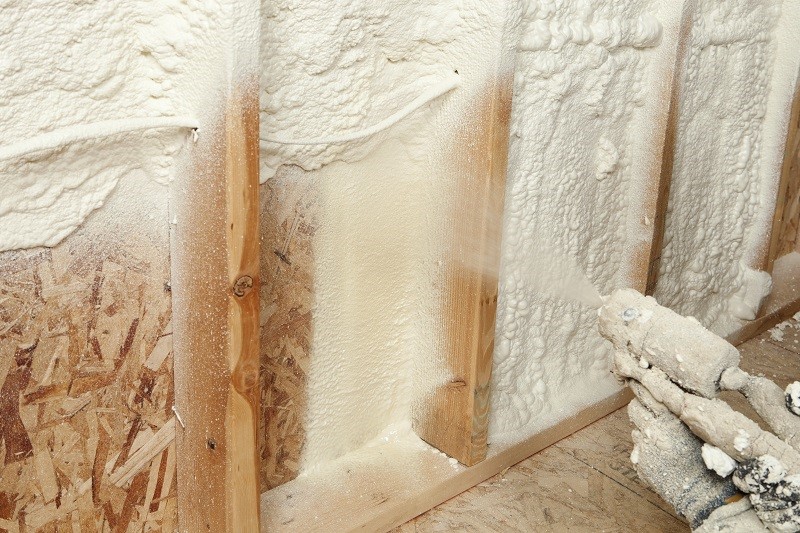Is Condensation on My Walls Normal?
Condensation on the walls of your home is not normal. Condensation can occur in bathrooms after a shower, or in the kitchen when cooking, but it should clear away relatively quickly and not linger. While condensation can occur, if it lasts long term as opposed to subsiding, it is typically a sign of a lack of insulation in your walls or poor ventilation in your home.
Why does condensation form on walls?
The condensation on walls inside a home occurs when the house is humid and the warm air hits cold walls. The warm air cools quickly after hitting the cold surface and forms droplets of water and condensation. This is also why you can see condensation on your windows as well.
Why does condensation form on my walls in the winter?
As stated above, condensation happens when warm air hits a cold surface. During the winter months, the air in your home is warm due to a furnace or air source heat pump running and hits the walls, which are often cooler due to lower outdoor temperatures.
Why does condensation form on my walls in the summer?
Condensation on your walls in the summer still occurs due to a discrepancy in the temperature of the air in your home and the walls. The best way to combat condensation in the summer is to provide proper ventilation. Ensuring the warm and moist air from the heat is being removed and replaced with fresh air is important for treating condensation on your walls in the summer.
Why do I have so much moisture in my home?
We create moisture in our homes throughout our day by doing normal things such as showering and cooking, even breathing can add moisture to the air.
Moisture can also sneak into your home in any small crack and crevices. Small openings in your roof are one of the top ways that moisture makes its way into your home as it rains or snows. These small openings are often found nearby chimneys, skylights and vents. Ice dams can also lead to moisture in your home. If the gutters cannot handle all of the melting water, it can make its way to the small openings.
Can condensation lead to mold?
Yes, condensation can lead to mold. The small water droplets from the condensation can lead to the wall being damp. If the walls are regularly damp, mold is more likely to start growing. It will start as small black dots that might not be noticeable until more starts to develop.
If the mold is caught early, a homeowner can clean up the mold themselves. The Environmental Protection Agency recommends using professionals if the mold is larger than a 3 ft. by 3 ft. area.
What is the best insulation to prevent condensation?
Closed cell spray foam insulation is recommended for the walls of Michigan homes. Closed cell spray foam insulation is mold resistant because it does not absorb moisture, which is important in the case condensation does occur. For new construction homes or remodeling projects, closed cell spray foam is applied to wall cavities before the drywall is installed.
If your home already has drywall or plaster and you are not planning to demo the walls, the best choice for insulation to prevent condensation is dense-packed cellulose insulation. The dense-packed cellulose insulation will not shrink like other forms of wall insulation so it will provide uniform coverage on your walls to avoid cold pockets.
No matter what insulation type your home has though, the insulation in your walls needs to meet the recommended R-value for your home’s climate.
Injection foam, which is different than closed cell spray foam, is not recommended to prevent condensation on your walls. It is a water-based foam so it is not water or mold resistant. Injection foam is susceptible to shrinkage which leads to cold pockets and can cause condensation spots to occur.
How to treat and prevent condensation on your walls
Treating and preventing future condensation on your walls is unique to your home. A few common ways to help prevent condensation on your walls are the following.
Increase ventilation
Improving the ventilation in your home will help to draw out the stale moist air and replace it with fresh outdoor air. If your home’s building envelope is tight it may not allow for your home to achieve air changes naturally, so you may need a mechanical ventilation system.
Use exhaust fans
Exhaust fans are commonly found in the kitchen and bathrooms of your home. They should be utilized to remove the moisture from bathing and cooking. It will also prevent the moisture from traveling further into your home.
Use a dehumidifier
Exhaust fans are not in every room of a home, which is why dehumidifiers can be helpful. A dehumidifier will remove excess moisture from the air to help prevent it from traveling toward your walls. A dehumidifier is primarily used during warmer months and is often essential for Michigan basements.
Are you concerned about condensation on the walls of your home?
Contact Ecotelligent Homes to evaluate your home’s insulation and ventilation during a home energy audit or to remove mold from your home’s walls.
